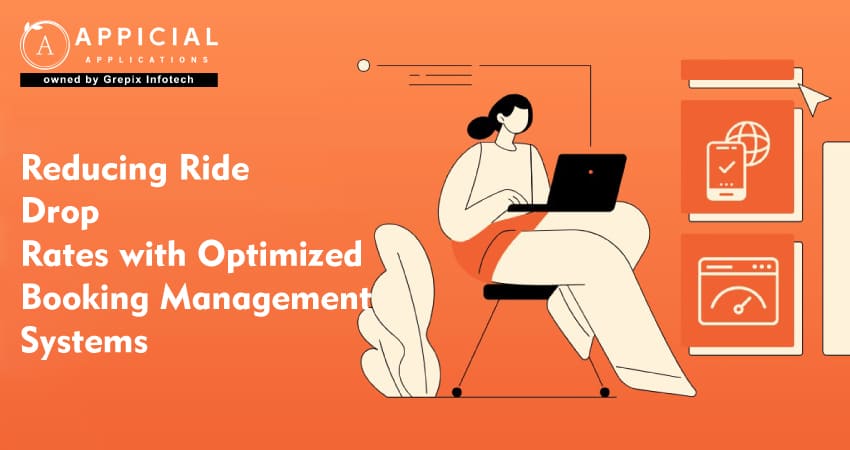
Reducing Ride Drop Rates with Optimized Booking Management Systems
In the ride hailing industry, one of the key friction points is ride drop rate, when confirmed bookings are dropped, canceled, or fail to materialize. A high drop rate affects user trust, driver earnings, platform reputation, and operational efficiency. For any serious Uber Clone, ride sharing app, ride hailing app, or e-hailing app, minimizing drops is not optional. It’s a critical success metric.
An optimized booking management system becomes the weapon to control drops. Whether you are running a white label taxi booking app or building from scratch with a taxi app development company, a robust booking management layer is essential.
In this blog, we dive into what causes drops, how booking management can reduce them, architectural strategies, monitoring, incentives, and implementation details. Finally, we show how Appicial Applications can help you build a high-reliability Uber Clone or ride hailing app with minimal drop rates.
This article examines the challenge of ride drop rates in ride-hailing ecosystems and shows how optimized booking management systems can significantly reduce dropouts. It covers root causes of ride drops, system design strategies, algorithmic solutions, monitoring, user/driver incentives, and technical best practices. The blog also explains how a taxi app development company or a white-label taxi app development company should approach this, and concludes with a pitch for Appicial Applications as your partner.
What Are Ride Drop Rates and Why Do They Matter?
Defining Ride Drop Rate
Ride drop rate refers to the proportion of bookings that are confirmed but later canceled, abandoned, or failed from either the user or driver side. In many markets, drop rates of 5% to 15% are common on early-stage platforms. But even 5 % has a serious business impact.
Impacts on User Trust and Retention
When a user experiences a drop (driver cancels, no one arrives), trust erodes. They may switch to competitors or revert to traditional cabs. High drop rates harm the perceived reliability of your ride-hailing app, ride-sharing app, or e-hailing app. It kills retention.
Revenue Loss and Operational Waste
Each drop represents lost revenue from fares, commissions, and trip volume. Also, drivers might have wasted time and effort reaching the pickup location. Platform resources (matching, routing) get wasted.
Driver Frustration and Attrition
Drivers dealing with cancellations or no-shows may become disillusioned. They may leave or reduce active time. Over time, attrition increases and supply stability is harmed. According to a study, driver supply attrition becomes significant over time once drop-offs are frequent.
Competitiveness in a Crowded Market
In crowded markets, reliability matters more than just cost. A white label taxi booking app or Uber Clone that consistently drops rides cannot compete. Minimizing drop is a differentiator.
What Causes High Ride Drop Rates?
Driver Rejection or Decline after Assignment
Drivers may reject or cancel after accepting due to distance, traffic, or a lower fare. If your booking management system doesn’t guard against that, drop rates surge.
Long Pickup Distances or Waiting Times
If the assigned driver is too far or the estimate says too long to arrive, drivers may drop to avoid idle time. Users may also cancel when waiting exceeds tolerance.
Inaccurate Demand Predictions and Overbooking
If the platform overcommits accepts more rides than driver capacity, some rides inevitably drop. Poor forecasting or a mismatch in logic causes this.
No-show by Riders or Change of Mind
Users cancel at the last minute or fail to show up. Without an effective penalty or deterrent, drop rates climb.
System or Network Failures
Technical issues, failed connectivity, push notification delays, mapping errors—can lead drivers not receiving or responding to assignments, causing dropouts.
Poor Incentives and Lack of Accountability
If drivers or users feel they can drop without cost, behavior becomes lax. Incentives or penalties matter in reducing drops.
Inadequate Fallback Logic
When a driver fails, if your system lacks a backup or reassign strategy, the ride is simply dropped.
How an Optimized Booking Management System Reduces Drop Rates?
Intelligent Dispatch and Assignment Algorithms
A booking management system should match drivers to bookings in a smart way. It should consider driver reliability, distance, acceptance history, and real-time conditions. Rather than randomly assign, the system should favor drivers with a high acceptance probability. This reduces potential drops.
Pre-acceptance Checks and Soft Confirmations
Before fully committing a driver, the system can issue a soft confirmation to test willingness. If the driver declines, it can skip fully committing. This helps avoid last-minute drop.
Buffering and Time Windows
Booking systems should incorporate buffer times. For instance, assign a slot rather than an exact moment. The system allows ±5 or ±10 minutes flexibility. This reduces stress on drivers and reduces drop due to tight schedules.
Overprovisioning Safely
In peak times, the system can provision slightly more driver assignments than guaranteed trips, expecting a fraction of drops, but with careful safety margins. This ensures there is enough backup supply.
Retry and Fallback Reassignment
If a driver cancels or is unreachable, the booking management system should immediately reassign to another driver. The faster the fallback, the less likely the ride is to be dropped.
Ride Expiration and Timeout Logic
If a driver does not respond within a threshold (e.g., 30 seconds), the system should revoke the assignment and reassign automatically.
Monitoring Driver Buffer and Fatigue
The system should monitor how many rides a driver is handling in sequence. Avoid overloading drivers — fatigue may lead to drop. Booking management modules should enforce cooling windows or rest intervals.
Penalty & Incentive Mechanisms
Incentivize drivers with bonuses for high acceptance/low cancellation. Penalize frequent drop behavior. The booking management system must integrate these rules. It increases accountability and reduces drop.
Rider Penalties / Deposit Systems
Require users to pay a small fee or a non-refundable deposit for booking. If they no-show, impose a penalty. Booking management should enforce that. It discourages dropping from rider's side.
Real-time Monitoring & Alerts
Continuously monitor drift from planned pickup times or driver status. If someone seems off track, alert backup drivers early or notify users. The booking management system can trigger dynamic interventions.
Reliability Scoring and Ranking
Assign reliability scores to drivers (based on acceptance, on-time rate, cancellations) and use that score in assignment logic. More reliable drivers get priority for bookings. This helps reduce drop. A taxi app development company, or a white-label taxi app development company, should build this scoring module.
Predictive Analytics and Machine Learning
Use historical data and ML models to anticipate drop risk for each booking. Flag high-risk bookings for special handling (backup driver, tighter assignment). Booking management should integrate predictive risk flags.
What Should Your Booking Management System Architecture Include?
Modular Booking Management Layer
Your ride-hailing app, ride-sharing app, or e-hailing app design should separate booking management as a module. It interacts with dispatch, driver module, notification, analytics, penalty engine, and fallback logic.
Real-time Data Feeds and Telemetry
Booking management must consume live driver location, status, traffic, ETA, and network health. Only with real-time data can it adapt assignments and fallback.
Asynchronous / Event-Driven Framework
Because assignments, acceptances, cancellations are asynchronous, use event-driven architecture (message queues, event buses) so booking decisions respond in milliseconds.
Scalability and Fault Tolerance
In peak times, the system should handle thousands of bookings concurrently. Booking management must scale horizontally and be fault-tolerant to prevent service interruptions caused by system failures.
Retry & Circuit Breaker Patterns
Use retry logic, circuit breaker patterns when external dependencies (map API, push notifications) fail. This ensures the booking logic continues even in the face of partial failures.
Logging, Telemetry, and Analytics Integration
Every assignment, accept, reject, and fallback must be logged. Booking management should feed data into analytics modules to generate insights, drop patterns, and performance metrics.
API Gateway & Microservices Interfaces
Booking management exposes APIs to the front-end app, driver app, dispatch engine, and support dashboards. Clean interfaces allow upgrades.
Security and Data Integrity
Booking data is critical. Booking management must validate inputs, secure endpoints, and guard against malicious cancellations or booking spoofing.
Testing & Simulation Capabilities
Simulate drop scenarios, test fallback paths, and stress test the booking management system before launch. A reliable taxi app development company, or a white-label taxi app development company, must build test-simulation layers.
What Are the Challenges & Risks in Booking Management?
Mis-predictions and False Positives
Your drop-risk model may flag low-risk bookings or miss high-risk ones. If fallback triggers too often, overhead costs rise. Balancing precision and recall is critical.
Latency and Response Time
Booking management must act quickly. If latency is high, drivers or riders may not get timely messages and cancel. Performance tuning is vital.
Complexity and Maintenance
Booking management logic grows complex over time. Without good architecture, it becomes brittle. A strong taxi app development company, or a white-label taxi app development company, is needed to maintain it.
Driver Pushback on Penalties
Drivers may resist strict penalty systems. The platform must balance enforceable rules with fair incentives. Booking management should mediate this carefully.
Rider Frustration with Fallback
If fallback reassignments cause delays or worse driver, users may be frustrated. Booking system must manage expectations and communications.
Edge Cases (Zones, Surges, Multi-legs)
In border zones or surge times, booking logic may fail. For rides crossing zones or during peak hours, fallback, buffer, and reassignment logic become more complex.
Data Privacy and Consent
Scoring and analytics must comply with data regulations (GDPR, local laws). Booking management must deal with anonymization, user privilege, and data access.
How Should Your Taxi App Development Strategy Adapt?
Selecting a Competent Taxi App Development Company
When you evaluate a taxi app development company or white label taxi app development company, ensure they have prior experience in robust booking management systems, assignment fallback, predictive engines, and operations at scale. Ask for design diagrams, reliability stats, and response to drop scenarios.
Phased Rollout of Booking Management Module
Don’t immediately launch the full booking logic system-wide. Start in a limited area, test fallback paths, monitor drops, tune parameters, then expand. This reduces the risk to your Uber Clone or white-label taxi booking app.
Integration with Dispatch, Driver, Notification Modules
Booking management must not be a standalone system; it should integrate deeply with dispatch, the driver app, notifications, and support systems. The ride-sharing app architecture must reflect these interdependencies.
Operational Support and Escalation Paths
Booking drops may require human intervention. Your support team should have dashboards from booking management showing at-risk rides, fallback actions, and the ability to manually intervene if needed.
Also Read: Smart Ride Cancellation Policies: Keeping Riders Happy and Drivers Productive
Driver Onboarding & Training
Educate drivers about acceptance, reliability, cancellation rules. Include rules in training and onboarding. Booking management success depends on driver cooperation.
Incentive Programs & Gamification
Tie driver incentive programs to reliability scores, low drop, and high acceptance. Booking management logic can integrate incentive modules to reward top performers.
Continuous Improvement and DevOps
Booking management should support continuous deployment, monitoring, rollback, and iteration. A solid DevOps pipeline is vital. They should support this culture.
Why Appicial Applications Is the Partner You Need?
Building a fault-tolerant, drop-resilient Uber Clone, ride-hailing app, or e-hailing app demands advanced booking management logic. You need modular architecture, predictive analytics, fallback mechanisms, reliability scoring, real-time monitoring, and more. Appicial Applications specializes in building white label taxi booking app solutions and customizing them deeply for your requirements. We are not just another taxi app development company; we are your strategic engineering partner.
Here’s what sets us apart:
- Deep expertise in booking management, drop mitigation, and matching logic.
- Experience building a full Uber Clone and ride-sharing app platforms that handle drop events robustly.
- Customizable reliability models, fallback logic, buffer strategies tuned to your region and user base.
- End-to-end integration: booking, driver assignment, fallback, notifications, analytics, support dashboards.
- Clean, modular architecture so you own your code while still getting maintenance and upgrades.
- Post-launch support, monitoring, refinement, and rapid iteration to continuously reduce drop.
- Balanced incentive / penalty systems integrated to keep both drivers and users accountable.
If you want your ride-hailing app or e-hailing app to maintain exceptionally low drop rates and grow a reputation for reliability, Appicial Applications is your ideal partner.
Don’t let ride drops undermine your platform’s potential. Contact Appicial Applications today for a free consultation and demo of a booking management system that can reduce drop-off rates by 50% or more in your Uber Clone or white-label taxi app. Let us engineer reliability into your mobility platform.
Conclusion
Ride drop rates are a silent killer of ride-hailing platforms. They damage user trust, waste operational resources, frustrate drivers, and erode reputation. The difference between a shaky ride-sharing app and a trusted ride-hailing app often lies in the strength of the underlying booking management system. By adopting intelligent dispatch, fallback logic, predictive drop risk analytics, buffer strategies, incentives, and real-time monitoring, you can dramatically reduce drop rates.
To build this, you need a skilled taxi app development company or a white-label taxi app development company that understands the nuances of drop mitigation. Appicial Applications brings this deep technical domain expertise, letting you focus on growth while we build a robust, drop-resilient booking backbone for your Uber Clone or e-hailing app.
Let us partner to build the most reliable ride-hailing solution your market has seen, drop-free, user-trusted, driver-efficient. Reach out no,w and let’s get started.
FAQs (Frequently Asked Questions)
Author's Bio

Vinay Jain is the Founder at Grepix Infotech and brings over 12 years of entrepreneurial experience. His focus revolves around software & business development and customer satisfaction.
Back to blog list




